wheel Abarth 500 2020 Owner handbook (in English)
[x] Cancel search | Manufacturer: ABARTH, Model Year: 2020, Model line: 500, Model: Abarth 500 2020Pages: 196, PDF Size: 3.53 MB
Page 112 of 196
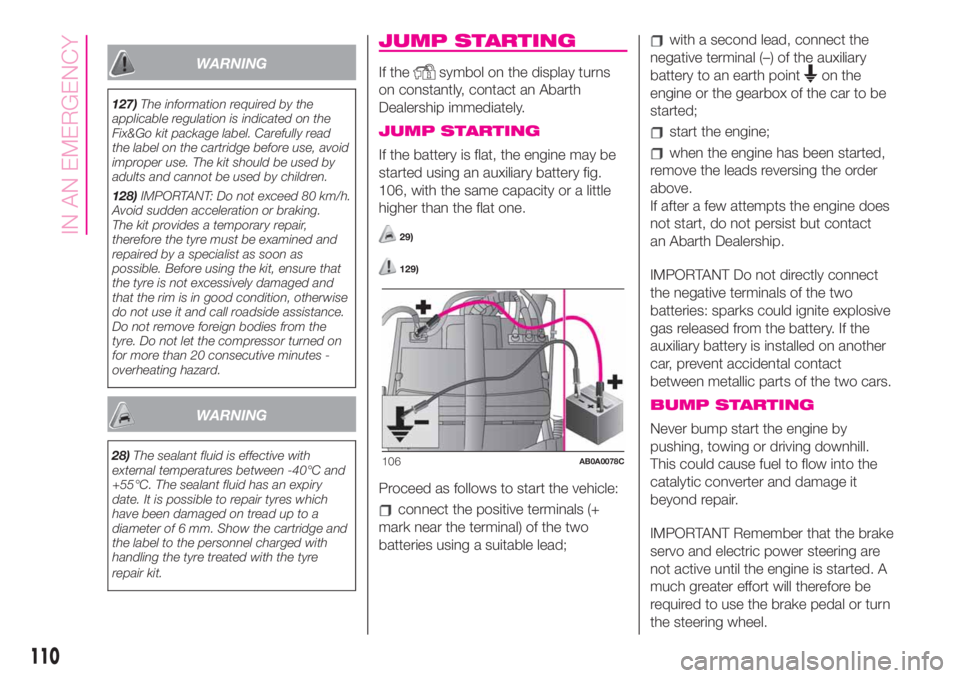
WARNING
127)The information required by the
applicable regulation is indicated on the
Fix&Go kit package label. Carefully read
the label on the cartridge before use, avoid
improper use. The kit should be used by
adults and cannot be used by children.
128)IMPORTANT: Do not exceed 80 km/h.
Avoid sudden acceleration or braking.
The kit provides a temporary repair,
therefore the tyre must be examined and
repaired by a specialist as soon as
possible. Before using the kit, ensure that
the tyre is not excessively damaged and
that the rim is in good condition, otherwise
do not use it and call roadside assistance.
Do not remove foreign bodies from the
tyre. Do not let the compressor turned on
for more than 20 consecutive minutes -
overheating hazard.
WARNING
28)The sealant fluid is effective with
external temperatures between -40°C and
+55°C. The sealant fluid has an expiry
date. It is possible to repair tyres which
have been damaged on tread up to a
diameter of 6 mm. Show the cartridge and
the label to the personnel charged with
handling the tyre treated with the tyre
repair kit.
JUMP STARTING
If thesymbol on the display turns
on constantly, contact an Abarth
Dealership immediately.
JUMP STARTING
If the battery is flat, the engine may be
started using an auxiliary battery fig.
106, with the same capacity or a little
higher than the flat one.
29)
129)
Proceed as follows to start the vehicle:
connect the positive terminals (+
mark near the terminal) of the two
batteries using a suitable lead;
with a second lead, connect the
negative terminal (–) of the auxiliary
battery to an earth point
on the
engine or the gearbox of the car to be
started;
start the engine;
when the engine has been started,
remove the leads reversing the order
above.
If after a few attempts the engine does
not start, do not persist but contact
an Abarth Dealership.
IMPORTANT Do not directly connect
the negative terminals of the two
batteries: sparks could ignite explosive
gas released from the battery. If the
auxiliary battery is installed on another
car, prevent accidental contact
between metallic parts of the two cars.
BUMP STARTING
Never bump start the engine by
pushing, towing or driving downhill.
This could cause fuel to flow into the
catalytic converter and damage it
beyond repair.
IMPORTANT Remember that the brake
servo and electric power steering are
not active until the engine is started. A
much greater effort will therefore be
required to use the brake pedal or turn
the steering wheel.
106AB0A0078C
110
IN AN EMERGENCY
Page 114 of 196

TOWING THE
VEHICLE
The tow hook, which is supplied with
the vehicle, is housed in the tool box,
under the carpet in the luggage
compartment.
131) 132) 133) 134) 135)
ATTACHING THE TOW
RING
Proceed as follows:
Front
release cap 1 fig. 107
take the tow hook 2 fig. 107 out of
its housing in the tool support;
fully tighten it on the threaded pin.
Rear
release cap 1 fig. 108
take the tow hook 2 fig. 108 out of
its housing in the tool support;
fully tighten it on the threaded pin.
Towing with robotised
sequential transmission
Make sure that the gearbox is in neutral
(N) (checking that the vehicle moves
when pushed) and proceed in the same
way as for towing a normal vehicle
with a manual gearbox. If the gearbox
cannot be put in neutral, do not tow the
car and contact an Abarth Dealership.
WARNING
131)Before towing, turn the ignition key to
MAR-ON and then to STOP without
removing it. The steering column
will automatically lock when the key is
removed and the wheels cannot be
steered.
132)Before tightening the ring clean the
threaded housing thoroughly. Make sure
that the ring is fully fastened in the housing
before towing the car.
133)The front and rear tow hooks should
be used only for emergencies on the road.
You are allowed to tow the vehicle for
short distances using an appropriate
device in accordance with the highway
code (a rigid bar), to move the vehicle on
the road in readiness for towing or
transporting via a breakdown vehicle. Tow
rings MUST NOT be used to tow vehicles
off the road or where there are obstacles
and/or for towing operations using cables
or other non-rigid devices. In compliance
with the above conditions, towing must
take place with the two vehicles (one
towing, the other towed) aligned as much
as possible along the same centre line.
107AB0A0398C
108AB0A0109C
112
IN AN EMERGENCY
Page 115 of 196

134)Whilst towing, remember that as the
assistance of the brake servo and the
electric power assisted steering is
not available, greater force needs to be
exerted on the brake pedal and more effort
is required on the steering wheel. Do not
use flexible cables when towing and avoid
jerky movements. During towing, make
sure that the trailer hitch does not damage
any components it is touching. When
towing the vehicle, you must comply with
all specific traffic regulations, both in terms
of the towing device and behaviour on
the road. Do not start the engine while
towing the car.
135)Because of its conformation, the car
cannot be loaded onto railway carriages
and transported.
113
Page 116 of 196

SERVICING AND CARE
Correct servicing permits the
performance of the vehicle to be
maintained over time, as well as limited
running costs and safeguarding the
efficiency of the safety systems.
This chapter explains how.SCHEDULED SERVICING ...............115
SERVICE SCHEDULE .....................116
PERIODIC CHECKS ........................120
DEMANDING USE OF THE CAR .....120
CHECKING LEVELS........................121
BATTERY ........................................125
BATTERY RECHARGING ................126
WINDSCREEN / REAR WINDOW
WIPERS ..........................................127
LIFTING THE CAR...........................128
WHEELS AND TYRES.....................128
BODYWORK ...................................129
INTERIOR .......................................132
114
SERVICING AND CARE
Page 130 of 196

Rear window washer
The rear window washer jets are fixed.
The nozzle holder is on the rear window
fig. 114.
WARNING
148)Driving with worn windscreen/rear
window wiper blades is a serious risk,
because visibility is reduced in bad
weather.
LIFTING THE CAR
36)
As a result of its sporty nature, the car
is fitted with aerodynamic spoilers at
the bottom and side skirts at the sides.
If the car needs to be raised, go to an
Abarth Dealership which is equipped
with arm lifts and workshop lifts.
WARNING
36)When positioning the workshop lift
arms, be very careful to avoid damaging
the aerodynamic spoilers and the side
skirts.
WHEELS AND TYRES
Check the pressure of each tyre,
including the space-saver wheel,
approximately every two weeks and
before long journeys: the pressure
should be checked with the tyre rested
and cold.
149) 150) 151) 152)
It is normal for the pressure to increase
when the car is used; for the correct
tyre inflation pressure, see “Wheels” in
the “Technical specifications” section.
SNOW TYRES
Use snow tyres of the same size as the
standard tyres provided with the car.
An Abarth Dealership will be happy to
provide advice concerning the most
suitable type of tyre for the Customer's
requirements.
153)
For the type of tyre to be used, inflation
pressures and the specifications of
snow tyres, follow the instructions given
in the "Wheels" paragraph in the
"Technical specifications" chapter.
114AB0A0115C
128
SERVICING AND CARE
Page 131 of 196
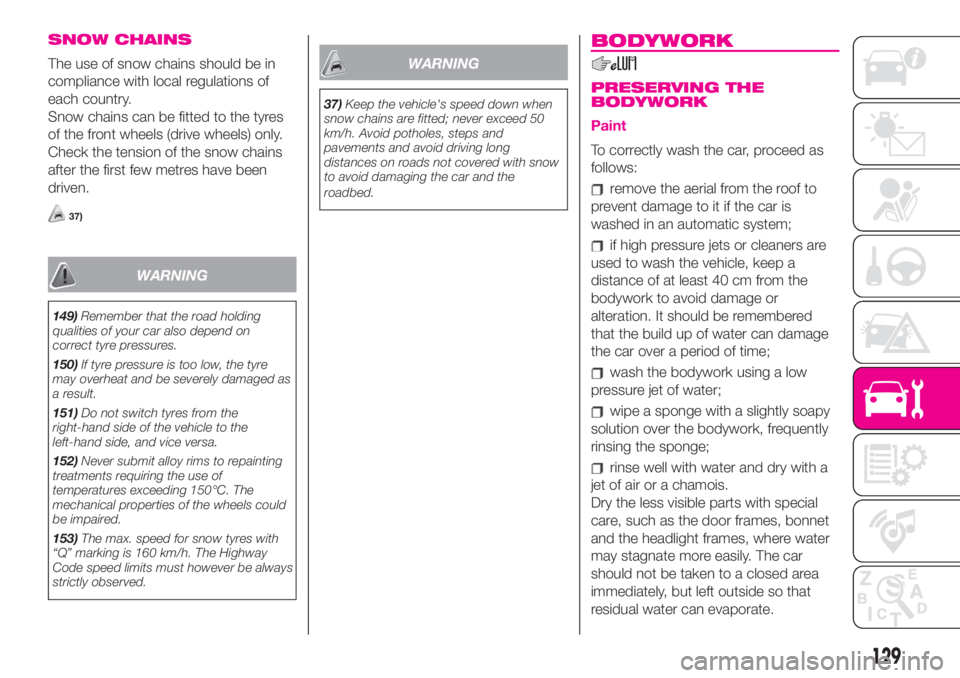
SNOW CHAINS
The use of snow chains should be in
compliance with local regulations of
each country.
Snow chains can be fitted to the tyres
of the front wheels (drive wheels) only.
Check the tension of the snow chains
after the first few metres have been
driven.
37)
WARNING
149)Remember that the road holding
qualities of your car also depend on
correct tyre pressures.
150)If tyre pressure is too low, the tyre
may overheat and be severely damaged as
a result.
151)Do not switch tyres from the
righthand side of the vehicle to the
lefthand side, and vice versa.
152)Never submit alloy rims to repainting
treatments requiring the use of
temperatures exceeding 150°C. The
mechanical properties of the wheels could
be impaired.
153)The max. speed for snow tyres with
“Q” marking is 160 km/h. The Highway
Code speed limits must however be always
strictly observed.
WARNING
37)Keep the vehicle's speed down when
snow chains are fitted; never exceed 50
km/h. Avoid potholes, steps and
pavements and avoid driving long
distances on roads not covered with snow
to avoid damaging the car and the
roadbed.
BODYWORK
PRESERVING THE
BODYWORK
Paint
To correctly wash the car, proceed as
follows:
remove the aerial from the roof to
prevent damage to it if the car is
washed in an automatic system;
if high pressure jets or cleaners are
used to wash the vehicle, keep a
distance of at least 40 cm from the
bodywork to avoid damage or
alteration. It should be remembered
that the build up of water can damage
the car over a period of time;
wash the bodywork using a low
pressure jet of water;
wipe a sponge with a slightly soapy
solution over the bodywork, frequently
rinsing the sponge;
rinse well with water and dry with a
jet of air or a chamois.
Dry the less visible parts with special
care, such as the door frames, bonnet
and the headlight frames, where water
may stagnate more easily. The car
should not be taken to a closed area
immediately, but left outside so that
residual water can evaporate.
129
Page 134 of 196
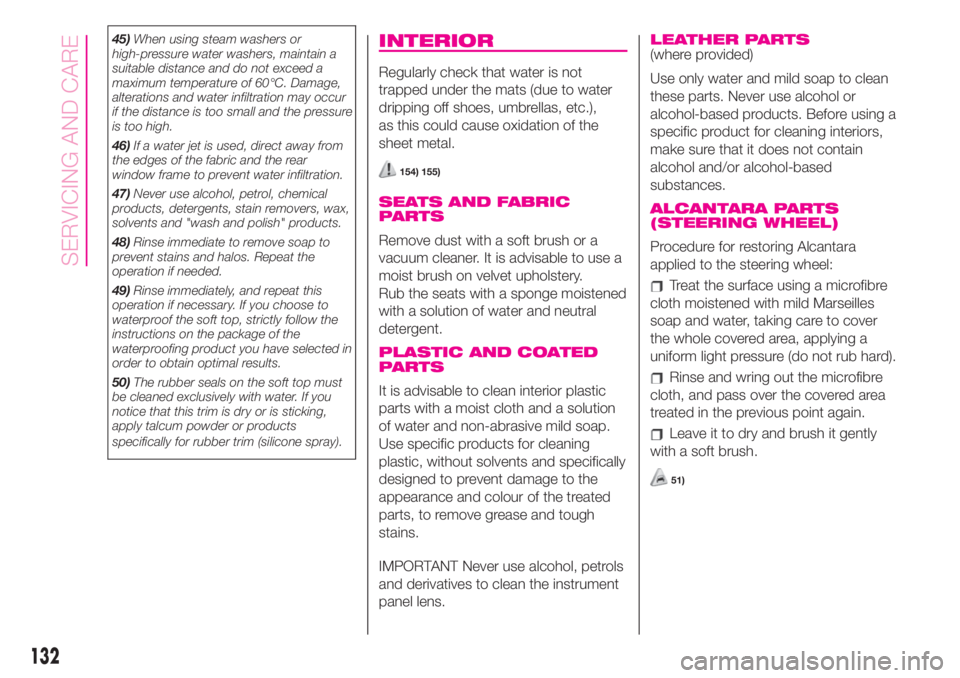
45)When using steam washers or
high-pressure water washers, maintain a
suitable distance and do not exceed a
maximum temperature of 60°C. Damage,
alterations and water infiltration may occur
if the distance is too small and the pressure
is too high.
46)If a water jet is used, direct away from
the edges of the fabric and the rear
window frame to prevent water infiltration.
47)Never use alcohol, petrol, chemical
products, detergents, stain removers, wax,
solvents and "wash and polish" products.
48)Rinse immediate to remove soap to
prevent stains and halos. Repeat the
operation if needed.
49)Rinse immediately, and repeat this
operation if necessary. If you choose to
waterproof the soft top, strictly follow the
instructions on the package of the
waterproofing product you have selected in
order to obtain optimal results.
50)The rubber seals on the soft top must
be cleaned exclusively with water. If you
notice that this trim is dry or is sticking,
apply talcum powder or products
specifically for rubber trim (silicone spray).INTERIOR
Regularly check that water is not
trapped under the mats (due to water
dripping off shoes, umbrellas, etc.),
as this could cause oxidation of the
sheet metal.
154) 155)
SEATS AND FABRIC
PARTS
Remove dust with a soft brush or a
vacuum cleaner. It is advisable to use a
moist brush on velvet upholstery.
Rub the seats with a sponge moistened
with a solution of water and neutral
detergent.
PLASTIC AND COATED
PARTS
It is advisable to clean interior plastic
parts with a moist cloth and a solution
of water and non-abrasive mild soap.
Use specific products for cleaning
plastic, without solvents and specifically
designed to prevent damage to the
appearance and colour of the treated
parts, to remove grease and tough
stains.
IMPORTANT Never use alcohol, petrols
and derivatives to clean the instrument
panel lens.
LEATHER PARTS(where provided)
Use only water and mild soap to clean
these parts. Never use alcohol or
alcohol-based products. Before using a
specific product for cleaning interiors,
make sure that it does not contain
alcohol and/or alcohol-based
substances.
ALCANTARA PARTS
(STEERING WHEEL)
Procedure for restoring Alcantara
applied to the steering wheel:
Treat the surface using a microfibre
cloth moistened with mild Marseilles
soap and water, taking care to cover
the whole covered area, applying a
uniform light pressure (do not rub hard).
Rinse and wring out the microfibre
cloth, and pass over the covered area
treated in the previous point again.
Leave it to dry and brush it gently
with a soft brush.
51)
132
SERVICING AND CARE
Page 136 of 196
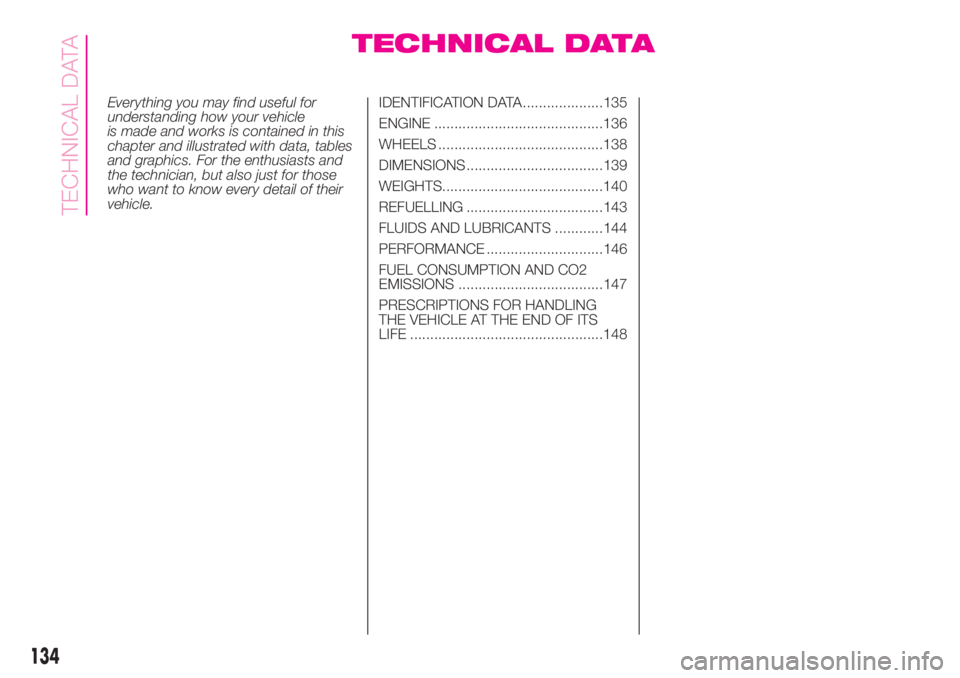
TECHNICAL DATA
Everything you may find useful for
understanding how your vehicle
is made and works is contained in this
chapter and illustrated with data, tables
and graphics. For the enthusiasts and
the technician, but also just for those
who want to know every detail of their
vehicle.IDENTIFICATION DATA....................135
ENGINE ..........................................136
WHEELS .........................................138
DIMENSIONS ..................................139
WEIGHTS........................................140
REFUELLING ..................................143
FLUIDS AND LUBRICANTS ............144
PERFORMANCE .............................146
FUEL CONSUMPTION AND CO2
EMISSIONS ....................................147
PRESCRIPTIONS FOR HANDLING
THE VEHICLE AT THE END OF ITS
LIFE ................................................148
134
TECHNICAL DATA
Page 140 of 196
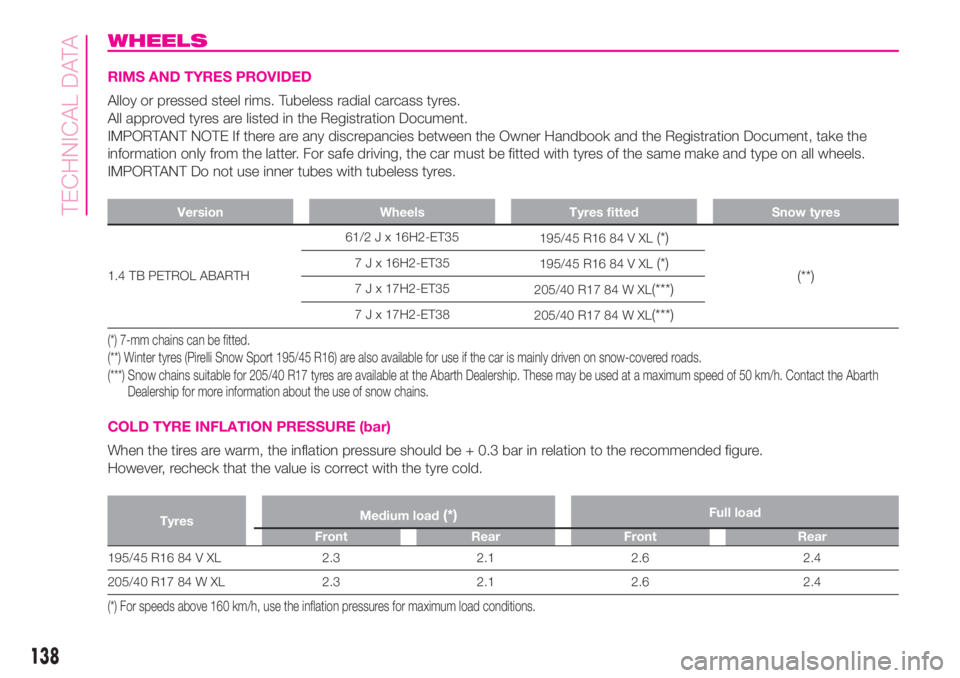
WHEELS
RIMS AND TYRES PROVIDED
Alloy or pressed steel rims. Tubeless radial carcass tyres.
All approved tyres are listed in the Registration Document.
IMPORTANT NOTE If there are any discrepancies between the Owner Handbook and the Registration Document, take the
information only from the latter. For safe driving, the car must be fitted with tyres of the same make and type on all wheels.
IMPORTANT Do not use inner tubes with tubeless tyres.
Version Wheels Tyres fitted Snow tyres
1.4 TB PETROL ABARTH61/2 J x 16H2-ET35
195/45 R16 84 V XL
(*)
(**)
7 J x 16H2-ET35
195/45 R16 84 V XL(*)
7 J x 17H2-ET35
205/40 R17 84 W XL(***)
7 J x 17H2-ET38
205/40 R17 84 W XL(***)
(*) 7-mm chains can be fitted.
(**) Winter tyres (Pirelli Snow Sport 195/45 R16) are also available for use if the car is mainly driven on snow-covered roads.
(***) Snow chains suitable for 205/40 R17 tyres are available at the Abarth Dealership. These may be used at a maximum speed of 50 km/h. Contact the Abarth
Dealership for more information about the use of snow chains.
COLD TYRE INFLATION PRESSURE (bar)
When the tires are warm, the inflation pressure should be + 0.3 bar in relation to the recommended figure.
However, recheck that the value is correct with the tyre cold.
TyresMedium load(*)Full load
Front Rear Front Rear
195/45 R16 84 V XL 2.3 2.1 2.6 2.4
205/40 R17 84 W XL 2.3 2.1 2.6 2.4
(*) For speeds above 160 km/h, use the inflation pressures for maximum load conditions.
138
TECHNICAL DATA
Page 146 of 196
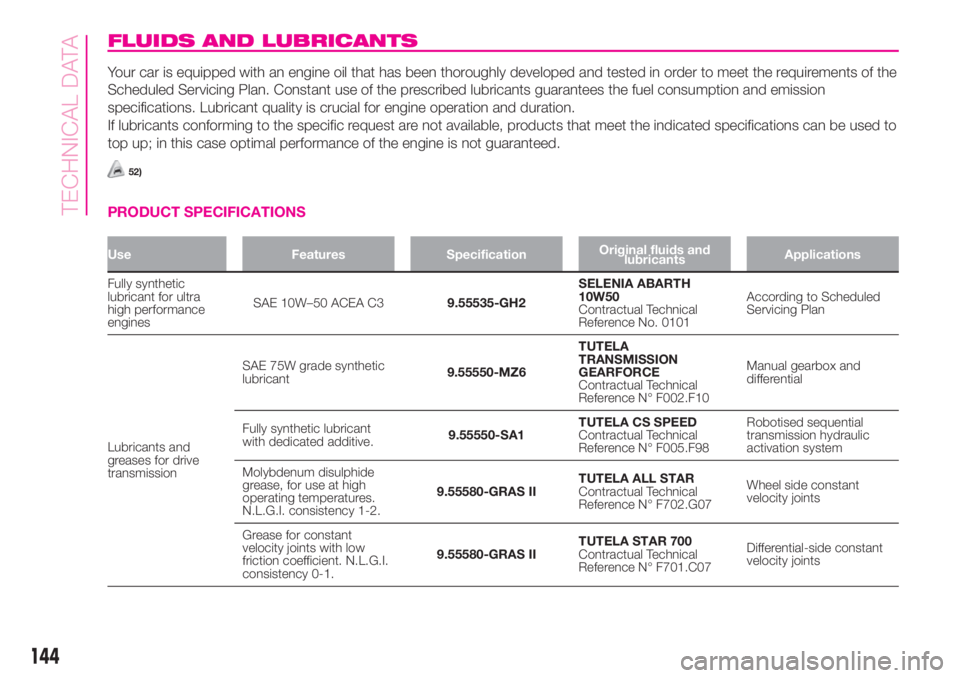
FLUIDS AND LUBRICANTS
Your car is equipped with an engine oil that has been thoroughly developed and tested in order to meet the requirements of the
Scheduled Servicing Plan. Constant use of the prescribed lubricants guarantees the fuel consumption and emission
specifications. Lubricant quality is crucial for engine operation and duration.
If lubricants conforming to the specific request are not available, products that meet the indicated specifications can be used to
top up; in this case optimal performance of the engine is not guaranteed.
52)
PRODUCT SPECIFICATIONS
Use Features SpecificationOriginal fluids and
lubricantsApplications
Fully synthetic
lubricant for ultra
high performance
enginesSAE 10W–50 ACEA C39.55535-GH2SELENIA ABARTH
10W50
Contractual Technical
Reference No. 0101According to Scheduled
Servicing Plan
Lubricants and
greases for drive
transmissionSAE 75W grade synthetic
lubricant9.55550-MZ6TUTELA
TRANSMISSION
GEARFORCE
Contractual Technical
Reference N° F002.F10Manual gearbox and
differential
Fully synthetic lubricant
with dedicated additive.9.55550-SA1TUTELA CS SPEED
Contractual Technical
Reference N° F005.F98Robotised sequential
transmission hydraulic
activation system
Molybdenum disulphide
grease, for use at high
operating temperatures.
N.L.G.I. consistency 1-2.9.55580-GRAS IITUTELA ALL STAR
Contractual Technical
Reference N° F702.G07Wheel side constant
velocity joints
Grease for constant
velocity joints with low
friction coefficient. N.L.G.I.
consistency 0-1.9.55580-GRAS IITUTELA STAR 700
Contractual Technical
Reference N° F701.C07Differential-side constant
velocity joints
144
TECHNICAL DATA